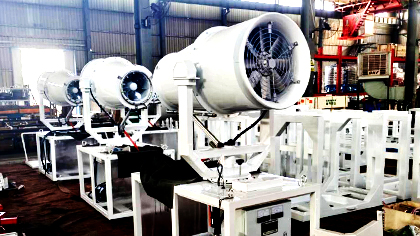Pitch Structure Configurations of Fog Cannons:
1.Pull Rod Control:Utilizes a cam transmission mechanism
featuring a speed reducer, cam disc, transmission rod, and
rod sleeve. A decelerating motor rotates the cam disc,
causing the transmission rod assembly to reciprocate
vertically. The rod sleeve on the blower's drive shaft moves
up and down accordingly. Advantages include simple
structure, precise vertical movement adjustment via the
pull rod's fixed position on the cam plate.
→industrial dust cannon machine
2.Electric Push Rod:A modern electric actuator comprising
motors, push rods, and control devices, enabling remote
and centralized control. Key advantages are its compact
design, high precision, excellent self-locking performance
driven directly by the motor.

3.Hydraulic Cylinder:Powered by a motor, it uses a two-way
gear pump to output pressure oil, controlling the
reciprocating motion of the piston rod via an oil circuit
manifold. Benefits include load start capability, overload
protection, low energy consumption, sealed structure for
longevity, and a self-locking mechanism ensuring the
piston rod remains in position post-motor shutdown.
Applications of Fog Cannons:
1.Industrial Use:Open-pit material storage yards, coal
logistics parks, mining operations, and bulk material
handling sites to control dust during loading, unloading,
and transportation.
2.Construction and Demolition:Dust suppression during
building demolition, construction waste handling, ship
transport, and road dust control from heavy-duty vehicle
operations.
3.Public and Environmental:Airfields, highways, stations,
docks, public spaces, and sports venues for dust
reduction, air cooling, and disinfection.










